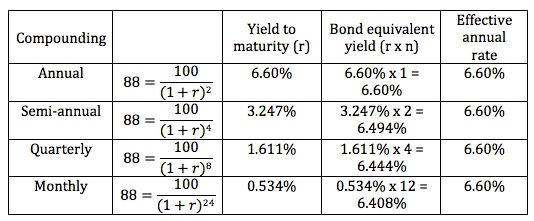- CFA Exams
- 2025 Level I
- Topic 6. Fixed Income
- Learning Module 7. Yield and Yield Spread Measures for Fixed-Rate Bonds
- Subject 1. Periodicity and Annualized Yields
Why should I choose AnalystNotes?
Simply put: AnalystNotes offers the best value and the best product available to help you pass your exams.
Subject 1. Periodicity and Annualized Yields PDF Download
Fixed-rate bonds are those that pay the same amount of interest throughout their specified term. Measurement for fixed-rate bonds depends on the timing of the bond's cash flows.
Yield measures are used to evaluate the rate of return on bonds.
- They are typically annualized.
- Money market rates are simple interest rates. They are annualized but NOT compounded.
- Non-money market rates are compounded.
Yields-to-maturity allow analysts to use a single measure to compare bonds with varying maturities and coupons.
The periodicity of an annual interest rate is the number of periods in the year.
Consider a two-year, zero-coupon bond priced now at 88 per 100 of par value.

Note:
- The effective annual rate is the same.
- The bond equivalent yield and the periodicity are inversely related.
- When comparing different bonds, it is essential to compare the yields for the same periodicity to make a statement about relative value.
To convert an annual yield from one periodicity to another:

Example
- A Eurobond pays coupons annually. It has an annual-pay YTM of 8%.
- A U.S. corporate bond pays coupons semi-annually. It has a bond equivalent YTM of 7.8%.
- Which bond is more attractive, if all else equal?
Solution 1
- Convert the U.S. corporate bond's bond equivalent yield to an annual-pay yield.
- Annual-pay yield = [1 + 0.078/2]2 - 1 = 7.95% < 8%
- Therefore, the Eurobond is more attractive since it offers a higher annual-pay yield.
Solution 2
- Convert the Eurobond's annual-pay yield to a bond equivalent yield (BEY).
- BEY = 2 x [(1 + 0.08)0.5 - 1] = 7.85% > 7.8%
- Therefore, the Eurobond is more attractive since it offers a higher bond equivalent yield.
User Contributed Comments 12
| User | Comment |
|---|---|
| CHADZAMIRA | This is reasonably straight forward but be careful with the conversion process. |
| ramtor | use the iconv function of BAII plus |
| JimM | Using the ICONV function of BAII plus (it's on the "2" key), remember to set C/Y = 2, not 365. NOM = BEY EFF = Annual-pay yield Set 1 of those, CPT the other. |
| jpducros | Remember that you'll always have : MMY<BEY<EAY MMY : Money Market Yield : no compounding - 360 d/year BEY : Bond Equiv. Yield : Semi-Annual Compounding - 365 d/y EAY : Effective annual Yield : compounding for the entire year, based on 365 d/y |
| anaraguin | Thank you so so much JimM! :) |
| moneyguy | That still doesn't tell me how to actually apply the iconv button to calculate this stuff, JimM |
| 2014 | thanks jim |
| tichas | Chadzamira , iwe |
| SAB1987 | Thank you JimM |
| davidbenke | @moneyguy US corporate bond example: [2nd][2] NOM = [7][.][8] C/Y = [2] EFF = [CPT] EFF should equal 7.952 |
| philerup | TIL how to use ICONV. Thanks Jim! |
| phill | why do them all have the same EAR and how is that calculated? |

I just wanted to share the good news that I passed CFA Level I!!! Thank you for your help - I think the online question bank helped cut the clutter and made a positive difference.

Edward Liu
My Own Flashcard
No flashcard found. Add a private flashcard for the subject.
Add